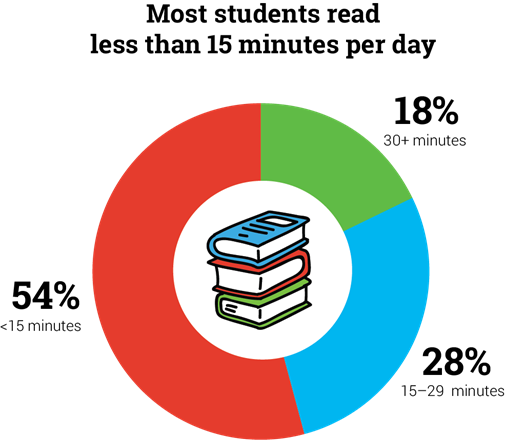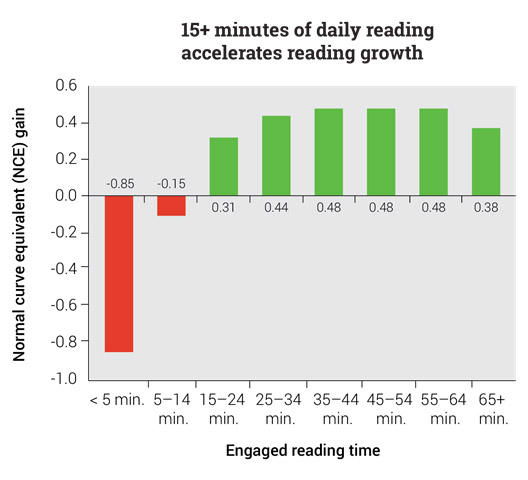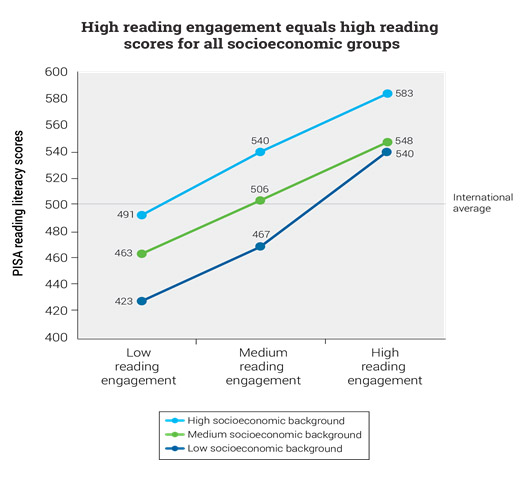Reading Time 15 Minutes
In my last post, I wrote about how the 5th-6th grade are key times when students start to read text that is well below their reading levels, and these times can be critical to the academic future of a student in the 5th-6th grade.
Many parents ask, “how much should my child be reading on their own?”. I don’t think anyone would be surprised to know that ALL students could benefit from more reading from more reading time. I’ve written that just “6 more minutes” of reading can make a huge difference. That 6 minutes gets most students up to the critical levels of total reading needed to see improvements.
A recent study by Renaissance of the reading practices of more than 9.9 million students over the 2015–2016 school year found that more than half of the students read less than 15 minutes per day on average!
15 minutes seems to be the “magic minutes” where students start to see significant gains in reading achievement. Yet less than half of students are achieving that threshold!
An analysis by Renaissance comparing the engaged reading time and reading scores of more than 2.2 million students found that students who read less than five minutes per day saw the lowest levels of growth, well below the national average. Even students who read 5–14 minutes per day saw sluggish gains that were below the national average.
Only students who read 15 minutes or more a day saw accelerated reading gains—that is, gains higher than the national average—and students who read just over a half-hour to an hour per day saw the greatest gains of all.
There are many other factors that contribute to achievement, such as quality instruction, access to reading materials, and family background. The consistent connection between time spent reading per day and reading growth cannot is the most crucial and easiest to rectify.
If reading practice is linked to reading growth and achievement, then it follows that low levels of reading practice should correlate to low levels of reading performance and high levels of reading practice should connect to high levels of reading performance. This pattern is precisely what we see in student test data.
The connection between reading practice and achievement
Scores of more than 174,000 students’ Programme for International Student Assessment (PISA) revealed that connection between reading engagement and reading performance was “moderately strong and meaningful” in all 32 countries examined, including the United States.3 On average, students who spent more time reading, read more diverse texts, and valued reading as an activity scored higher on the PISA’s combined reading literacy scale. No one should be surprised by these statistics!
The study also found a student’s level of reading engagement was more highly correlated with their reading achievement than their socioeconomic status, gender, family structure, or time spent on homework. Students with the lowest socioeconomic background but high reading engagement scored better than students with the highest socioeconomic background but low reading engagement.
Overall, students with high reading engagement scored significantly above the international average on the combined reading literacy scale, regardless of their family background. The opposite was also true, with students with low reading engagement scoring significantly below the international average, no matter their socioeconomic status.
The authors suggested that reading practice can play an “important role” in closing achievement gaps between different socioeconomic groups. Frequent high-quality reading practice may help children compensate for—and even overcome—the challenges of being socially or economically disadvantaged, while a lack of reading practice may erase or potentially reverse the advantages of a more privileged background. In short, reading practice matters for kids from all walks of life.
Let me know your thoughts, reply to this email or text me at the number below!




